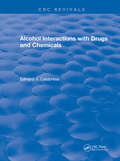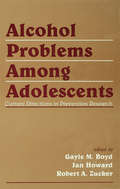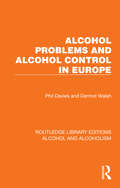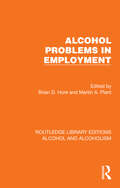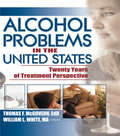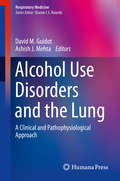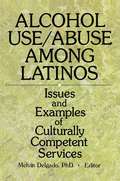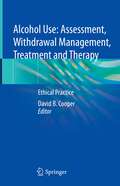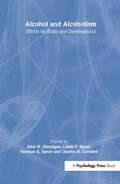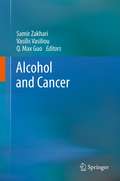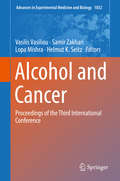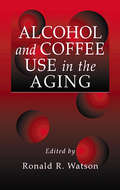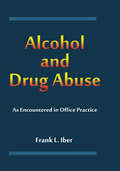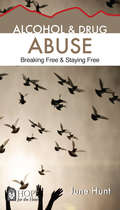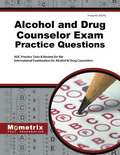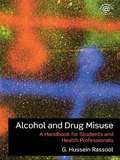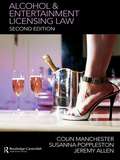- Table View
- List View
Alcohol Interactions with Drugs and Chemicals (CRC Press Revivals)
by Edward J. CalabreseAlcohol Interactions with Drugs and Chemicals is a concise volume that identifies, documents, and assesses the capacity of alcohol to alter the toxicity of chemical pollutants and drugs in animal models and humans. The book systematically assesses interactions according to general chemical classes of inorganic and organic agents. It also presents an integrative discussion of the significance of these findings to public health.Alcohol Interactions with Drugs and Chemicals will be a valuable reference tool for environmental scientists, toxicologists, epidemiologists, and alcohol researchers studying the interactions of alcohol with drugs and chemical pollutants.
Alcohol Nation: How to protect our children from today's drinking culture
by Dr Aric SigmanWe are a nation that loves to drink. And we're passing the habit on to our children. But a growing body of compelling new evidence about the dangers of alcohol consumption at a young age will force us to reconsider the entire way we view alcohol and young people. As parents, we need to talk to our children about alcohol but many of us are not sure what to say. In this essential book, Dr Aric Sigman ties up all the latest medical research and cultural issues and puts them into context. Most importantly he addresses drinking not just as a teenage problem but as an integral part of our history and culture. It will lead us to understand how the way we view alcohol impacts directly upon our chidlren's present and future health, wellbeing and academic success, and it will answer the question, 'how can I reconcile my enjoyment of drinking with ensuring my child grows up knowing how to drink sensibly?'.
Alcohol Problems Among Adolescents: Current Directions in Prevention Research
by Gayle M. Boyd Jan Howard Robert A. ZuckerAlcohol misuse presents a major risk for health and well-being throughout the life-span, but youth have a special vulnerability. Alcohol is the most widely used drug by adolescents. For some, this may be one or two isolated occasions of youthful experimentation; for others, the use becomes excessive, placing them in danger of immediate adverse consequences such as accidental injury and alcohol poisoning, or encouraging other high-risk behavior patterns including unprotected sex. Moreover, a pattern of heavy drinking established in adolescence and young adulthood may continue into an adult pattern of alcohol abuse. Concerned communities and institutions across the nation are tackling the problem of alcohol use and abuse by young people. Research-based knowledge is urgently needed to inform these efforts and to ensure that limited prevention resources are used as effectively as possible. The origins of youthful alcohol use and abuse are found within the complex interplay of individual characteristics, family and peer influences, the larger societal context for alcohol use, environmental conditions, and maturational processes that accompany adolescence. This volume, which began as a special issue of the Journal of Research on Adolescence, contains all of the material from the journal issue plus additional chapters. It helps researchers to meet the tremendous challenge of disentangling the key determinants of risk, and developing effective interventions. Primary sources of influence on youthful alcohol use are described, ranging from individual expectancies about alcohol effects and cognitive decision processes to parenting practices, peer influences, social environments, and economic factors; and a corresponding range of prevention interventions is discussed. This book will serve as a primer to those with an interest in developing and improving effective programs and activities to reduce alcohol-related problems among young people. For those engaged in prevention research, the text will provide useful reviews and current findings that should aid in directing future research activities.
Alcohol Problems and Alcohol Control in Europe (Routledge Library Editions: Alcohol and Alcoholism)
by Dermot Walsh Phil DaviesThe nature of alcohol problems is very diverse and the strategies adopted for minimising these vary even more. Thinking in the study of alcohol problems in the 1970s and early 1980s had focused on the public health perspective, seeking not only to lessen alcohol problems by controlling the availability of alcohol, but also to promote moderate drinking practices and to preserve the positive advantages of alcohol use. Originally published in 1983, a detailed review of public health issues in this field at the time opens the book. This is followed by an examination of alcohol-related problems and policies for their control in sixteen different European countries. The chapters on individual countries provide a source of information and data on alcohol policies, consumption and problems with which it is possible to examine from a cross-cultural and comparative basis the claims of a public health perspective. The final chapter draws together the cross-national data and discusses their implications for a public health response to alcohol problems. This book should now be a historical reference source for all interested in health policy in general and alcohol problems in particular.
Alcohol Problems in Employment (Routledge Library Editions: Alcohol and Alcoholism)
by Brian D. Hore Martin A. PlantThe majority of problem-drinkers are not unemployed derelicts but are employed persons often with senior positions in commerce, the professions and industry. Furthermore, it is well-known that alcohol causes widespread absenteeism, inefficiency and accidents at work. Originally published in 1981, Alcohol Problems in Employment reviews the evidence relating to the general effects of alcohol misuse on employment and the special problems involved in certain ‘high-risk’ industries at the time. A number of international case studies are then presented to illustrate what was being done to counter the problem.
Alcohol Problems in the Community
by Larry HarrisonCommunity surveys reveal that about 6% of the adult male and 1% of the adult female population in England and Wales are drinking at high risk levels. Alcohol Problems in the Community examines the implications of recent community care legislation for government policy on alcohol. The first part of the book begins with a report on recent US research on the role of alcohol in the perpetration of child abuse and recent research on young people's drinking problems. This is followed by a study on the prevalence of drinking problems amongst older people which has been underestimated. In the second half of the book empirical evidence is presented on the particular difficulties faced by ethnic, migrant and homeless groups and this emphasis on the centrality of social disadvantage leads on to a consideration of a specific social work role in the assessment and management of alcohol-related problems. Alcohol Problems in the Community is aimed at social work practitioners and students on prequalifying, qualifying and postqualifying social work courses, and it addresses key social work issues in relation to poverty, homelessness, discrimination and drinking problems.
Alcohol Problems in the United States: Twenty Years of Treatment Perspective
by William White Thomas F McgovernAlcohol Problems in the United States: Twenty Years of Treatment Perspective presents an overview of trends in the treatment of alcohol problems over a 20-year period from three vantage points: broader treatment perspectives, experienced views from the field, and personal perspectives. Some of the field's foremost experts, including Alcoholics Anonymous historian Dr. Ernest Kurtz and Dr. Robert Sparks, who chaired the committee that authored the Institute of Medicine&’s highly influential study, "Broadening the Base of Treatment for Alcohol Problems," provide practical information on the vital treatment issues you deal with every day. By detailing treatment histories of the recent past, contributors offer a look at likely future trends that will help keep your treatment methods up to date. Treatment topics addressed in Alcohol Problems in the United States: Twenty Years of Treatment Perspective include: alcoholism as a disease alcohol dependence and mental illness the role of spirituality the growth and decline of treatment programs at the Mayo Clinic and Timberlawn Hospital and the special treatment needs of women, youths, African Americans, Native Americans, the Latino community, and the incarcerated. Alcohol Problems in the United States: Twenty Years of Treatment Perspective chronicles the story of alcohol treatment from historical and personal perspectives, offering the opportunity to anticipate future trends in the many challenges associated with alcohol problems. The book is an essential resource for professional alcoholism counselors, social workers, psychologists, physicians, clergy, nurses, employee assistance professionals, and anyone who provides care and service to those struggling with alcohol.
Alcohol Use Disorders and the Lung: A Clinical and Pathophysiological Approach (Respiratory Medicine #14)
by David M. Guidot Ashish J. MehtaAlcohol Use Disorders and the Lung: A Clinical and Pathophysiological Approach is an excellent resource for clinicians who care for individuals affected by alcohol use disorders in diverse settings. Although alcohol abuse alone does not cause acute lung injury, it renders the lung susceptible to dysfunction in response to the inflammatory stresses of sepsis, trauma, and other clinical conditions recognized to cause acute lung injury. In parallel, these same pathophysiological effects of alcohol abuse significantly increase the risk of a wide range of serious lung infections. Many clinicians involved in the primary treatment of alcohol use disorders, such as addiction psychiatrists, will find this text of interest as it will expand their understanding of the health consequences of alcohol use disorders. In parallel, clinicians who specialize in pulmonary and/or critical care medicine will have a unique resource that provides a comprehensive review of the pathophysiology of alcohol-related lung disorders and insights into evolving therapeutic options in these vulnerable individuals. Alcohol Use Disorders and the Lung: A Clinical and Pathophysiological Approach fills a gap in the literature and presents the evolving clinical research that may soon lead to novel therapies that can improve lung health in individuals with alcohol use disorders and co-existing conditions such as HIV infection.
Alcohol Use/Abuse Among Latinos: Issues and Examples of Culturally Competent Services
by Melvin DelgadoIn Alcohol Use/Abuse Among Latinos: Issues and Examples of Culturally Competent Services, you will learn how to design and improve services for Latinos with substance abuse problems by understanding that the cultures and personal backgrounds of your clients are crucial to the counseling process. This text will also show you how these service skills apply to the individual, family, or an entire community. Studies show that, according to patients, culturally sensitive and responsive practitioners are generally more credible, trusted, and effective. Alcohol Use/Abuse Among Latinos takes into account several different aspects that will help you develop these traits and provide successful services for Latinos dealing with alcohol or other drug problems. You&’ll gain valuable insight into:the five elements that are vital to a successful ATOD (Alcohol, tobacco and Other Drug) service--multiculturism, resilience/strengths, competence, community capacity development, and community participation--plus a detailed explanation of why they are needed step-by-step instructions for using three methods, supervision, inservice training, and consultation, as means of providing ongoing learning of cross-cultural competencies to practitioners why key factors such as economic background, gender, and sexual orientation need to be taken into consideration for ATOD services to be effective demographic patterns and case studies of Latino users and abusers of alcohol and other drugs that illustrate the growing number of Latinos in need of ATOD services why the practitioner needs to be aware of how family importance, values attached to cooperation versus competition, sociability, respect, and action-oriented problem-solving play a role in effective services for Latinos the need for practitioners to understand how ethnic identity, biculturality, Spanish language fluency, gender-specific role expectations, skin color, and overall sense of self can affect the success of services for Latino teenagers how excessive marketing of alcohol to Latino communities, lack of representation, and a lack of community involvement are key barriers to successful ATOD services for LatinosAlcohol Use/Abuse Among Latinos also discusses Latino mens’and womens’individual needs concerning substance abuse. One of the topics addressed, the loss of self-esteem, has been found to be a contributing factor to alcohol use and abuse for Latinas. It offers ways you can promote self-esteem in your Latina clients by focusing on their cultural heritage and pride. In addition, this text takes a unique look Latina lesbians and how training through educational and agency internship programs can promote awareness to your clients&’ special needs concerning substance abuse. Alcohol Use/Abuse Among Latinos will help you provide all of your Latino clients with efficient and culture-friendly services for resisting or overcoming the abuse of alcohol, tobacco, or other drugs.
Alcohol Use: Ethical Practice
by David B. CooperThe book brings together the most up-to-date knowledge and expertise covering the whole topic of alcohol. It presents the practical skills needed to offer ethical intervention and treatment and implement ethical person-centered care. It is a practice-based text that aims to improve ethical relationships, responses, care and practice necessary to be effective in interventions and treatment with those experiencing alcohol use and health problems. The focus is on combining the principles and philosophy of alcohol prevention and intervention, in hospital and community. Each chapter provides self-assessment exercises, reflective practice exercises, key points and a "to learn more" section, and develops a theoretical framework, before broadening to include application in care and practice. This work will appeal to a wide readership, from professionals working within the mental health care and practice environment to mental health students.
Alcohol and Aggression (Routledge Library Editions: Alcohol and Alcoholism)
by Paul F. BrainIn the 1980s the relationship between alcohol and aggression and violence was a controversial one. Much of previous thinking had been based on anecdotal evidence. In contrast this book, originally published in 1986, is based upon recent scientific evidence from a broad range of studies from animal experimentation to clinical and social research. The initial chapters describe what aggression is, in terms of theories of animal behaviour, how alcohol influences neural and endocrine functions and behaviour and how problematic it often is to extrapolate from animal research to humans. Later chapters give critical reviews of attempts to relate alcohol intake to violence and crime. The book represents a major synthesis of work from many disciplines and will interest workers in animal behaviour, alcohol studies, psychopharmacology and social psychology.
Alcohol and Aging: Clinical and Public Health Perspectives
by Alexis Kuerbis Alison. A. Moore Paul Sacco Faika ZanjaniThis book provides a current perspective on alcohol and aging to better understand the trends, costs, benefits, and clinical and community evidenced-based strategies. This book embraces not only the physical, cognitive, psychological, and social health benefits of moderate drinking in the elderly, it also delves into the risks of excessive drinking, including physical and psychiatric morbidity, neurodegeneration, medication complications, and accidents and injuries, and loss of independence. Written by experts in the field, this book is the only current text that includes the most current scientific, research, empirical, and practice information alongside a comprehensive review of the status of the field that will help guide alcohol use management and stimulate future research. Alcohol and Aging is the ultimate resource for all researchers, educators, clinicians, and professionals working with older adults who drink.
Alcohol and Alcohol-related Diseases
by Markus Heilig Sebastian MuellerAlcohol is one of the major risk factors for negative health outcomes worldwide. It accounts for more than 60 alcohol-related diseases, ranging from addiction, through liver cirrhosis, to cancer. Collectively, these conditions account for mortality and morbidity that make alcohol use one of the leading preventable causes of disability adjusted life-years (DALYs) lost globally. In this book, an international faculty covers all aspects of alcohol-related disorders, ranging from addiction/alcohol use disorders (AUD) to alcohol-related diseases of other organs such as liver, heart or cancer. A special focus is to reach out to primary care physicians who are in the front line of this major health problem. The book also provides an update for addiction specialists, as well as specialists in internal medicine, gastroenterology and hepatology. The book is divided into sections that include epidemiology, alcohol use disorders and addiction, alcohol-related liver disease, alcoholic hepatitis, primary care and interdisciplinary approaches and other alcohol-related diseases. Besides current diagnostic measures and treatment strategies, the book deals with the many underlying molecular and genetic mechanisms of alcohol toxicity. Novel insights include prospective data on all-cause mortality and the emerging major role of alcohol-mediated hemolysis and enhanced red blood cell turnover. The book also aims at guiding policy makers to handle the topic of alcohol in our society more responsibly.
Alcohol and Alcoholism: Effects on Brain and Development
by Norman E. Spear John H. Hannigan Linda P. Spear Charles R. GoodlettThis is the first volume that focuses on the lifespan neurobehavioral factors likely to determine susceptibility to alcohol abuse and its consequences. The chapters offer careful analysis of the effects of ethanol on the fetus, the infant, the adolescent, and the adult. The authors include behavioral neuroscientists and clinical neuropsychologists. Their topics range from the neurochemical and neuroanatomical consequences of prenatal alcohol to the cognitive consequences of prenatal alcohol on preschool and school-age children. The impact of genetics on sensitivity to alcohol is considered in terms of analytic tests using techniques of behavioral genetics and molecular biology. The consequences of exposure to alcohol during breastfeeding are described in experiments with human infants. The alcoholism that develops in adulthood is analyzed through the experimental study of relapse from alcohol deprivation and assessment of neuropsychological impairments and treatment for alcoholics. Drawing on extensive research that has applied techniques from molecular neurobiology and tests of learning and memory to the clinical assessment and treatment of alcoholics. The volume answers recent questions raised by the National Institute of Alcohol Abuse and Alcoholism and the National Institute of Drug Abuse about the role of early experience in susceptibility to later abuse of alcohol and other drugs. Although epidemiological studies can describe the problem, solutions in terms of mechanisms that mediate these effects will be found only with the kinds of experimentally oriented approaches the chapter authors describe.
Alcohol and Cancer (Advances in Experimental Medicine and Biology #815)
by Samir Zakhari Vasilis Vasiliou Q. Max GuoThe World Health Organization has identified chronic alcohol consumption as one of the top ten risk factors for worldwide burden of disease. The International Agency for Research on Cancer has identified alcohol as carcinogenic to humans, including cancers of the upper aerodigestive tract, colon, liver and breast. Alcohol's actions may be direct e.g. effects on retinoic acid and one-carbon metabolism, or indirect, through metabolites such as acetaldehyde and reactive oxygen species or through various signaling pathways that influence cell cycle and apoptosis that may contribute to carcinogenesis. This report reviews the state of the art in alcohol-related cancer research in ten chapters.
Alcohol and Cancer: Proceedings of the Third International Conference (Advances in Experimental Medicine and Biology #1032)
by Samir Zakhari Vasilis Vasiliou Helmut K. Seitz Lopa MishraFollowing the Third Alcohol and Cancer Conference, this volume compiles the most up-to-date research on the role of alcohol consumption in carcinogenesis, from epidemiology to pathology metabolism and stem cells. More specifically, it delves into the effects of alcohol consumption and thyroid cancer, CD133+ progenitor cells, carcinogenic iron accumulation, developmental morphogens, and cancer-inducing epigenetic changes. Alcohol and Cancer: Proceedings of the Third International Conference is a timely update to Biological Basis of Alcohol-Induced Cancer, which followed the Second Alcohol and Cancer Conference, compiling cutting-edge research from graduate students, young scientists, and researchers. It is ideal for graduate students and researchers in oncology, hepatology, epigenetics, and alcohol consumption.
Alcohol and Coffee Use in the Aging
by Ronald R. WatsonAs we age, our physiology changes. Also, we tend to place less emphasis on proper nutrition. The more elderly we grow, the less resistant we become to major diseases such as cancer and heart disease. This state of affairs renders the elderly more vulnerable to alcohol and other drugs of abuse. Alcohol and tobacco are routinely used together. Chroni
Alcohol and Crime
by Gavin DingwallAlcohol is massively associated with crime. Evidence from the British Medical Association found that alcohol use is associated with 60-70 per cent of murders, 70 per cent of stabbings, 50 per cent of fights or assaults in the home. For non-violent offences the association is very strong as well: 88 per cent of those arrested for criminal damage, 83 per cent for breach of the peace, 41 per cent for theft and 26 per cent for burglary, had drunk in the four hours prior to their arrest. At the same time there has been intense concern about public drunkenness in town and city centres, especially on the part of young people, and the cost and damage this causes. This book seeks to understand the nature of the connection between alcohol and crime, and the way the criminal justice system responds to the problem, providing a clear and accessible account and analysis of the subject. It draws upon a wide range of sources and research findings, and also sets the subject within a broader comparative context. It takes an interdisciplinary approach, and includes a sociological account of the role of alcohol in British society, a criminological analysis of the link between alcohol and crime and a philosophical consideration of individual responsibility for harm caused whilst intoxicated, and a legal analysis of different approaches that can be adopted as a response to alcohol-related offending.
Alcohol and Drug Abuse as Encountered in Office Practice
by Frank L. IberThis book has been written to serve as a manual for physicians practicing in a private office setting to recognize and recommend appropriate treatment for patients believed to be substance abusers. While it is not written for drug abuse specialists, it provides information regarding the diagnosis and treatments a competent, concerned physician can provide without becoming immersed in addiction treatment. Topics discussed include the degree to which a physician should become involved, when it is appropriate to refer, using other professions and volunteer groups, and useful medications. Guidelines for recognizing substance abuse, testing to confirm the abuse, confronting the patient, and motivating the patient into specific treatment are also presented. Tables and illustrations are used to summarize major points, making this an extremely useful reference tool for internists and other non-specialist private practitioners.
Alcohol and Drug Abuse: Breaking Free & Staying Free (Hope for the Heart)
by June HuntAlcohol and Drug Abuse--Breaking Free and Staying FreeMany people who have an alcohol or drug abuse problem deny it, saying they can stop any time they want. But family and close friends suspect it might be something more. Do you often wonder, "Is it really an addiction?" And if so, do you know how to help your loved one to break free? Can a person be set free permanently from a chemical dependency?The answer is YES--there is hope! Christian recovery and healing can take place, and June Hunt, author of Alcohol and Drug Abuse: Breaking Free & Staying Free offers sound biblical and practical advice for helping your loved one quit the cycle of drug and alcohol abuse for good! The Lord wants to heal those struggling with addictions. It's never too late to ask God for a renewed soul, free from whatever weighs them down. In just 96 pages, this mini-book will give you a good overview of the causes and signs of drug and alcohol abuse, and will give you the next steps to take. Getting educated is one of the steps. Learn the helpful definitions that clarify the difference between drug use, substance abuse, and dependency. Other definitions include:• Four major drug classifications• Three leading indicators of addiction• Codependency: both a relationship addiction and a substance addiction? • How a person with an addiction can continue their destructive patterns. Does your loved one have a chemical dependency? Find out in the 19-question checklist on drug or alcohol addiction provided in this book The section titled "Steps to Solutions" is filled with Christian recovery advice including Scripture and practical steps that point to:• Deliverance from dependency• 7 don'ts for being freed from an addiction• 10 spiritual tips for recovery• How to conduct a crisis intervention• And much more
Alcohol and Drug Counselor Exam Practice Questions: ADC Practice Tests and Review of the International Examination for Alcohol and Drug Counselors
by ADC Exam Secrets Test Prep Staff<p>Alcohol and Drug Counselor Exam Practice Questions are the simplest way to prepare for the Alcohol and Drug Counselor test. Practice is an essential part of preparing for a test and improving a test taker's chance of success. The best way to practice taking a test is by going through lots of Alcohol and Drug Counselor practice questions. <p>Our Alcohol and Drug Counselor Exam Practice Questions give you the opportunity to test your knowledge on a set of questions. You could know everything that is going to be covered on the test but still perform poorly if you have not had a chance to practice. Repetition is a key to success and using Alcohol and Drug Counselor practice test questions allows you to reinforce your strengths and improve your weaknesses. <p>Detailed answer explanations are also included for each question. It may sound obvious, but you have to know which questions you missed (and more importantly why you missed them) to be able to avoid making the same mistakes again when you take the real test. That's why our Alcohol and Drug Counselor Exam Practice Questions include answer keys with detailed answer explanations. These in-depth answer explanations will allow you to better understand any Alcohol and Drug Counselor questions that were difficult for you or that you needed more help to understand.</p>
Alcohol and Drug Misuse: A Guide for Health and Social Care Professionals
by G. Hussein RassoolWritten by an experienced academic author, lecturer and practitioner, this comprehensive textbook provides an introduction to alcohol and drug misuse. It presents: the context of alcohol and drug misuse, and the nature and theories of addiction, including a historical overview and policy initiatives in contemporary society an overview of the problems associated with psychoactive substances and their impact on groups such as culturally and linguistically diverse communities, young people, women, older people and the homeless an understanding of the generic role responses to substance misuse in a variety of different settings and contexts, including primary care, the community and hospitals a framework for assessment, care planning, harm reduction approaches, dealing with overdose, intoxication and withdrawals, and psychological and pharmacological interventions an accessible and skills-oriented approach to assist students and practitioners in dealing with alcohol and drug misuse. This new edition is fully updated and includes new material on: evidence-based pharmacological interventions; recent global strategies in alcohol and drug; dual diagnosis and women; shisha smoking; and current statistics on prevalence of alcohol and drug misuse Alcohol and Drug Misuse takes into account current policy and practice for substance use and misuse and includes a range of pedagogical features to enhance learning. It is essential reading for nursing, health and social work students taking substance misuse modules, as well as related CPD courses for health and social care professionals.
Alcohol and Drug Misuse: A Guide for Health and Social Care Professionals
by G. Hussein RassoolThis comprehensive textbook provides an accessible and skills-oriented introduction to alcohol and substance misuse for healthcare students and practitioners new to the field.Divided into five parts, this text explores: The context of alcohol and drug misuse and the nature and theories of addiction, including a historical overview and policy initiatives in contemporary society. An overview of psychoactive substances and the problems associated with them. An exploration of the impact of psychoactive substances on groups, such as culturally and linguistically diverse communities, young people, women, older people, and the homeless. An understanding of the generic role responses to substance misuse in a variety of different settings and contexts, including primary care, the community, and hospitals. A framework for assessment, care planning, harm reduction approaches, dealing with overdose, intoxication and withdrawals, and psychological and pharmacological interventions. This new edition is fully updated and includes expanded coverage of performance-enhancing drugs, e-cigarettes, cannabis use, gender disparities in substance use and treatment, public health approaches to substance use, and screening tools for alcohol misuse. Alcohol and Drug Misuse is enhanced with activities and learning outcomes throughout.It is essential reading for nursing, healthcare, and social work students taking substance misuse modules, as well as related post-registration/qualification courses for health and social care professionals.
Alcohol and Drug Misuse: A Handbook for Students and Health Professionals
by G. Hussein RassoolWritten by an experienced author and lecturer, this five part text presents an introduction to drug and alcohol misuse and provides: the context of alcohol and drug misuse, and the nature and theories of addiction, including a historical overview and policy initiatives in contemporary society an overview of the problems associated with psychoactive substances and their impact on groups such as black and minority ethnic people, young people, women, older people and the homeless an understanding of the generic role responses to substance misuse in a variety of different settings and contexts, including primary care, community and hospitals a framework for assessment, care planning, harm reduction approach, dealing with overdose, intoxication and withdrawals, psychological and pharmacological interventions an accessible and skills-oriented approach to assist students and practitioners in dealing with drug and alcohol misuse. Alcohol and Drug Misuse takes into account current policy initiatives and practice for substance use and misuse and includes a range of pedagogical features to enhance learning. It is essential reading for nursing and health students taking substance misuse modules, as well as related CPD courses for health care professionals.
Alcohol and Entertainment Licensing Law
by Colin Manchester Susanna Poppleston Jeremy AllenThis comprehensive and authoritative guide to licensing law is co-authored by the UK’s only professor of licensing law and two eminent licensing practitioners. It provides a detailed exposition and contextual analysis of the legal provisions governing the licensing of alcohol and entertainment under the Licensing Act 2003, encompassing both the legislative and decision-making framework of the Act as well as its implications for human rights. Fully updated and revised, it covers the various forms of authorization for licensable activities and licence and certificate conditions that might be attached as well as the enforcement and appeal provisions of the Act. This new edition, building on the highly acclaimed original work published in 2005, includes subsequent legislative changes and case law decisions. New additions to this edition include: expanded coverage of enforcement provisions and police powers a revised and extended chapter on appeals, in light of the practical and procedural developments that have evolved in the appeal process amendments to existing regulations and the revised Statutory Guidance issued in 2007. This book is essential reading for all local authorities, legal advisers, licensing policy advisors, operators and the police as well as those applying for licences.
